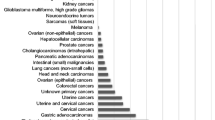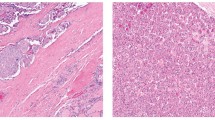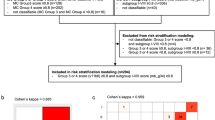Abstract
Genetically, chromophobe renal cell carcinoma (ChRCC) is characterized by multiple chromosomal changes, especially losses. The most common losses include chromosomes 1, 2, 6, 10, 13, 17, and 21. The Fuhrman grading system lacks prognostic relevance for ChRCC, and recently, a new grading system for ChRCC was proposed by Paner. The objective of this study was to map the spectrum of chromosomal aberrations (extent and location) in a large cohort of ChRCCs and relate these findings to the Paner grading system (PGS). A large cohort of ChRCC was reviewed and graded according to the PGS. All the cases were reevaluated and separated into groups according to their PGS. The final study set was 37 patients. ChRCCs were divided into PG 1–3, sarcomatoid, and aggressive groups. “Aggressive ChRCCs” were designated cases with known metastatic activity, local recurrence, aggressive growth to the adjacent organs, or invasive growth into the renal sinus (with/without angioinvasion). Sarcomatoid tumors were divided into their epithelial and sarcomatoid component (further molecular genetic analyses were performed separately). Array comparative genome hybridization and/or fluorescence in situ hybridization analysis was applied to 42 samples from the 37 cases. Multiple losses, as well as gains, were detected in different chromosomes. Regardless of the PGS groups, the most frequently detected losses involved chromosomes 1 (27/37), 2 (26/37), 6 (23/37), 10 (26/37), 13 (19/37), and 17 (24/37). Loss of chromosome 21 was found in 12/37 cases. The most frequently detected gains were found on chromosomes 4 (22/37), 7 (24/37), 15 (20/37), 19 (22/37), and 20 (21/37). Cluster analysis showed that there is no relation between PGS and particular pattern of chromosomal changes (losses or gains) in ChRCCs. Conclusions are as follows: (1) ChRCCs showed a significantly broader spectrum of chromosomal aberrations than previously recognized. While previously published chromosomal losses were found in our cohort, gains of multiple chromosomes were also identified in a high percentage. The most frequently detected gains involved chromosomes 4, 7, 15, 19, and 20. (2) There is no relation between chromosomal numerical changes and Paner grading system.





Similar content being viewed by others
References
Thoenes W, Stoerkel S, Rumpelt HJ (1985) Human chromophobe cell carcinoma. Virchows Arch (B) 48:207–17
Thoenes W, Storkel S, Rumpelt HJ et al (1988) Chromophobe cell renal carcinoma and its variants—report on 32 cases. J Pathol 155:277–87
Amin MB, Paner GP, Alvarado-Cabrero I, Young AN, Stricker HJ, Lyles RH, Moch H (2008) Chromophobe renal cell carcinoma: histomorphologic characteristics and evaluation of conventional pathologic prognostic parameters on 145 cases. Am J Surg Pathol 32:1822–34
Fuhrman SA, Lasky LC, Limas C (1982) Prognostic significance of morphologic parameters in renal cell carcinoma. Am J Surg Pathol 6:655–63
Paner GP, Amin MB, Alvarado- Cabrero I, Young AN, Stricker HJ, Moch H, Lyles RH (2010) A novel tumor grading scheme for chromophobe renal cell carcinoma. Prognostic utility and comparison with Fuhrman nuclear grade. Am J Surg Pathol 10:1233–39
Perez-Pedrosa A, Ortiz-Rey JA, Lorenzo-Mahía Y, Iglesias-Rodriguez B, Peteiro-Cancelo A, Gonzalez-Carrero JY (2012) Reproducibilidad interobservador de un sistema de grado para el carcinoma de celulas renales tipo cromofobo. Actas Urol Esp. doi: http://dx.doi.org/10.1016/j.acuro.2012.04.005
Cheville JC, Lohse CM, Sukov WR, Thompson RH, Leibovich BC (2012) Chromophobe renal cell carcinoma: the impact or tumour grade on outcome. Am J Surg Pathol 36:851–56
Alimchandani M, Neira de Paz C, Williams S, Lara-Otero K, Linehan WM, Merino MJ (2013) Aggressive variants of chromophobe renal cell carcinoma: importance of recognition and grading. Mod Pathol Suppl 2:192A–794
Bugert P, Kovacs G (1996) Molecular differential diagnosis of renal cell carcinoma by microsatellite analysis. Am J Pathol 149:2081–88
Brunelli M, Eble JN, Zhang S, Martignoni G, Delahunt B, Cheng L (2005) Eosinophilic and classic chromophobe renal cell carcinomas have similar frequent losses of multiple chromosomes from among chromosomes 1, 2, 6, 10 and 17 and this pattern of genetic abnormality is not present in oncocytoma. Mod Pathol 18:161–69
Speicher MR, Schoel B, du Manoir S, Schröck E, Ried T, Cremer T, Störkel S, Kovacs A, Kovacs G (1994) Specific loss of chromosomes 1, 2, 6, 10, 13, 17 and 21 in chromophobe renal cell carcinomas revealed by comparative genomic hybridisation. Am J Pathol 145:356–64
Brunelli M, Delahunt B, Gobbo S, Tardanico R, Eccher A, Bersani S, Cossu-Rocca P, Parolini C, Balzarini P, Menestrina F, Cheng L, Eble JN, Martignoni G (2010) Diagnostic usefulness of fluorescent cytogenetics in differentiating chromophobe renal cell carcinoma from renal oncocytoma. A validation study combining metaphase and interphase analyses. Am J Clin Pathol 133:116–26
Eble JN, Sauter G, Epstein JI, Sesterhenn IA (2004) Tumours of the urinary system and male genital organs. World Health Organisation Classification of Tumours. IARC, Lyon
Hagenkord JM, Gatalica Z, Jonasch E, Monzon FA (2011) Clinical genomics of renal epithelial tumors. Cancer Genetics 204:285–97
Brunelli M, Gobbo S, Cossu-Rocca P, Cheng L, Hes O, Delahunt B, Pea M, Bonetti F, Mina MM, Ficarra V, Chilosi M, Eble JN, Menestrina F, Martignoni G (2007) Chromosomal gains in the sarcomatoid transformation of chromophobe renal cell carcinoma. Mod Pathol 20:303–9
Tan M-H, Wong CF, Tan HL, Yang XJ, Ditlev J, Matsuda D, Khoo SK, Sugimura J, Fujioka T, Furge KA, Kort E, Giraud S, Ferlicot S, Vielh P, Amsellem-Ouazana D, Debré B, Flam T, Thiounn N, Zerbib M, Benoît G, Droupy S, Molinié V, Vieillefond A, Tan PH, Richard S, Teh BT (2010) Genomic expression and single-nucleotide polymorphism profiling discriminates chromophobe renal cell carcinoma and oncocytoma. BMC Cancer 10:196
Vieira J, Henrique R, Ribeiro FR, Barros-Silva JD, Peixoto A, Santos C, Pinheiro M, Costa VL, Soares MJ, Oliveira J, Jerónimo C, Teixeira MR (2010) Feasibility of differential diagnosis of kidney tumors by comparative genomic hybridization of fine needle aspiration biopsies. Genes Chromosom Cancer 49:935–47
Kim HJ, Shen SS, Ayala AG, Ro JY, Truong LD, Alvarez K, Bridge JA, Gatalica Z, Hagenkord JM, Gonzalez-Berjon JM, Monzon FA (2009) Virtual-karyotyping with SNP microarrays in morphologically challenging renal cell neoplasms: a practical and useful diagnostic modality. Am J Surg Pathol 33:1276–86
Yokomizo A, Yamamoto K, Furuno K, Shiota M, Tatsugami K, Kuroiwa K, Naito S (2010) Histopathologic subtype-specific genomic profiles of renal cell carcinomas identified by high-resolution whole-genome single nucleotide polymorphism array analysis. Oncology Letters 1:1073–78
Meyer PN, Cao Y, Jacobson K, Krausz T, Flanigan RC, Picken MM (2008) Chromosome 1 analysis in chromophobe renal cell carcinomas with tissue microarray (TMA)-facilitated fluorescence in situ hybridization (FISH) demonstrates loss of 1p/1 which is also present in renal oncocytomas. Diagn Mol Pathol 17:141–44
Akthar M, Chantziantoniou N (1999) Quantitative image cell analysis of cytologic smears for DNA ploidy in renal parenchymal neoplasms. Diagn Cythopathol 21:223–29
Kovacs A, Kovacs G (1992) Low chromosome number in chromophobe renal cell carcinomas. Genes Chromosom Cancer 4(3):267–68
Yusenko YV, Kuiper RP, Boethe T, Ljungberg B, van Kessel G, Kovacs G (2009) High-resolution DNA copy number and gene expression analyses distinguish chromophobe renal cell carcinomas and renal oncocytomas. BMC Cancer 9:152
Kuroda N, Tamura M, Hes O, Michal M, Shuin T, Toi M, Hayashi Y, Lee GH (2011) Chromophobe renal cell carcinoma with prominent lymph node metastasis and polysomy of chromosome 21: poorly differentiated form or “presarcomatoid” form? Med Mol Morphol 44(3):168–73
Gunawan B, Bergmann F, Braun S, Hemmerlein B, Ringert RH, Jakse G, Füzesi L (1999) Polyploidization and losses of chromosomes 1, 2, 6, 10, 13, and 17 in three cases of chromophobe renal cell carcinomas. Cancer Genet Cytogenet 110:57–61
Verdofer I, Hobisch A, Hittmair A, Duba HC, Bartsch G, Utermann G, Erdel M (1999) Cytogenetic characterization of 22 human renal cell tumors in relation to a histopathological classification. Cancer Genet Cytogenet 111:61–70
Bugert P, Gaul C, Weber K, Herbers J, Akhtar M, Ljungberg B, Kovacs G (1997) Specific genetic changes of diagnostic importance in chromophobe renal cell carcinoma. Lab Invest 76:203–8
Schwerdtle RF, Storkel S, Neuhaus C, Bauch H, Weidt E, Brenner W, Hohenfellner R, Huber C, Decker HJ (1996) Allelic losses at chromosomes 1p, 2p, 6p, 10p, 13q, 17p, and 21q significantly correlate with the chromophobe subtype of renal cell carcinoma. Cancer Res 56:2927–30
Iqbal MA, Akhtar M, Ali MA (1996) Cytogenetic findings in renal cell carcinoma. Hum Pathol 27:949–54
van Dongen JJ, Langerak AW, Bruggemann M, Evans PA, Hummel M, Lavender FL, Delabesse E, Davi F, Schuuring E, García-Sanz R, van Krieken JH, Droese J, González D, Bastard C, White HE, Spaargaren M, González M, Parreira A, Smith JL, Morgan GJ, Kneba M, Macintyre EA (2003) Design and standardization of PCR primers and protocols for detection of clonal immunoglobulin and T-cell receptor gene recombinations in suspect lymphoproliferations: report of the BIOMED-2 Concerted Action BMH4-CT98-3936. Leukemia 17:2257–317
Petersson F, Vaněček T, Michal M, Martignoni G, Brunelli M, Halbhuber Z, Spagnolo D, Kuroda N, Yang X, Cabrero IA, Hora M, Branžovský J, Trivunic S, Kacerovská D, Steiner P, Hes O (2012) A distinctive translocation carcinoma of the kidney; “rosette forming”, t(6;11), HMB45-positive renal tumor: a histomorphologic, immunohistochemical, ultrastructural, and molecular genetic study of 4 cases. Hum Pathol 43(5):726–36
Acknowledgments
This study was supported by the Charles University Research Fund (project number P36), by the project CZ.1.05/2.1.00/03.0076 from the European Regional Development Fund, and by a grant from the Charles University (SVV 6805).
Conflict of interest
All authors declare no conflict of interest.
Author information
Authors and Affiliations
Corresponding author
Rights and permissions
About this article
Cite this article
Sperga, M., Martinek, P., Vanecek, T. et al. Chromophobe renal cell carcinoma—chromosomal aberration variability and its relation to Paner grading system: an array CGH and FISH analysis of 37 cases. Virchows Arch 463, 563–573 (2013). https://doi.org/10.1007/s00428-013-1457-6
Received:
Revised:
Accepted:
Published:
Issue Date:
DOI: https://doi.org/10.1007/s00428-013-1457-6




